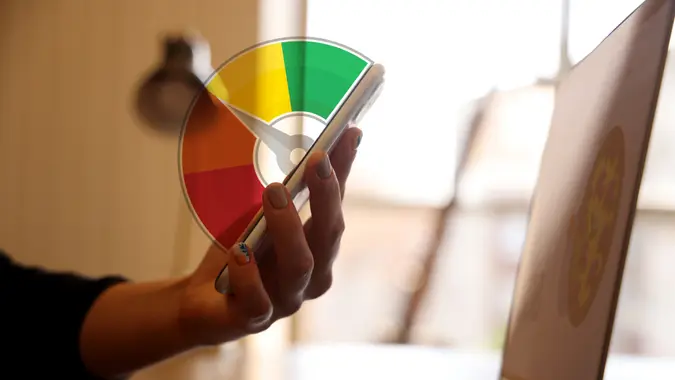How Do Personal Loans Work?

Commitment to Our Readers
GOBankingRates' editorial team is committed to bringing you unbiased reviews and information. We use data-driven methodologies to evaluate financial products and services - our reviews and ratings are not influenced by advertisers. You can read more about our editorial guidelines and our products and services review methodology.

20 Years
Helping You Live Richer

Reviewed
by Experts

Trusted by
Millions of Readers
The way personal loans work is pretty simple. As a borrower, you get a certain amount of money from a lender. You agree to pay it back, with interest, over a certain period.
Most personal loans are unsecured, which means that you don’t have to put up any collateral like your house or your car.
How Do Personal Loans Work for Borrowers and Lenders?
A personal loan involves two parties: the borrower and the lender. Here’s how it works for each of them.
For borrowers:
- You apply for a specific amount of money to be repaid over a specific period of time at a specific rate of interest.
- When approved, the bank gives you a lump sum.
- You make monthly payments, which consist of principal and interest.
- Use the money for whatever you want.
- If you miss payments or make them late, your credit may be affected, and you can be charged late fees.
For lenders:
- You assess the applicant’s creditworthiness to determine if you want to lend to them, and at what interest rate.
- You give the borrower a lump sum of money when the loan is approved.
- You collect the payments each month. The interest is your profit on the loan.
- If the borrower defaults, you could lose the money.
Principal and Interest Defined
- Principal: The amount you borrowed divided by the number of months in which you agreed to pay it back
- Interest: A percentage of the borrowed amount, spread over the term of the loan.
How Does Taking Out a Loan Work?
Here are the steps to take to get a personal loan.
- Research lenders to find the best rate.
- Apply for the loan, providing personal information and proof of your income.
- Agree to a credit check.
- Get approved by the lender and sign the loan agreement.
- Receive the money in a lump sum.
- Make monthly payments as agreed until the loan is paid off.
How Do You Get a Personal Loan?
To get a personal loan, you’ll want to start on the right foot. That means making sure your credit score is top-notch, and that you’ve got a list of lenders that suit your situation.
Check Your Credit Score
You’ll first start by checking your credit score. Make sure there are no errors on your credit report that are bringing your score down.
Consider a Variety of Lenders
Compare lenders to find the best rate, and then submit your application. Provide the information the lender requests in a timely manner, and follow up if you don’t get a response.
Learn more in our guide on how to get a personal loan.
How Do Bank Loans Work vs. Online Loans?
Bank loans and online loans work in the same general way, but a bank may take longer to approve your loan than an online lender.
A bank may also be more likely to take your personal situation into account, especially if you’ve been a customer for some time. An online lender may be more flexible if your credit isn’t perfect.
| Application | Bank Loans | Online only |
|---|---|---|
| Speed | Slower — between 3 to 7 days | Faster — 1 to 3 days |
| Relationship | May favor account holders | No relationship needed |
| Credit standards | May require higher scores | More flexible for fair credit |
How Does Interest Work on a Personal Loan?
When a bank loans money, they charge interest — this is their profit for lending the funds. Interest works on personal loans as the cost lenders charge you to borrow money, typically through an annual percentage rate (APR).
For a personal loan, the interest is calculated based on:
- Interest rate
- Amount borrowed
- Length or term of the loan
How a Loan Works: An Example
- You take out a $5,000 loan for two years at 10% interest.
- At first glance, you might expect to repay $5,500 — $5,000 and $500 in interest.
- However, personal loan interest is typically compounded monthly, meaning you’ll pay slightly more.
- For this example:
- Monthly payment: $230.72.
- Total payments over 24 months: $5,537.39.
- The extra cost comes from the compounding of interest over the loan term.
What Are Personal Loans Used For?
You can use a personal loan for just about anything, but they are commonly used for consolidating higher interest debt, such as credit cards, emergencies and major expenses.
Consider carefully whether you want to take out a personal loan. After all, you’re agreeing to pay for it for many months to come.
Pros and Cons of Personal Loans
| Pros | Cons |
|---|---|
| Fast access to money when you need it | Interest can be high, especially if your credit is fair or poor. |
| Fixed monthly payments | Missed or late payments will hurt your credit. |
| No collateral required | Some loans have fees, like origination or late fees. |
| Typically, a better interest rate than a credit card |
Is a Personal Loan Right for You?
A personal loan is a good choice for you if:
- Need a lump sum fast
- Have good or excellent credit
- Can make the monthly payments
You shouldn’t take out a personal loan if you:
- Can pay cash or qualify for cheaper financing
- Can’t afford the monthly payments
- Don’t have a clear need for the funds
How Personal Loans Can Help You Move Forward
Once you know how a personal loan works, you’ll have a better chance of getting ahead on your finances, control your debt and make life easier to manage.
You can use a personal loan to consolidate debt, cover an emergency or for a major purchase. When personal loans are used wisely, they can be an incredible tool to improve your financial situation and meet your goals.
Our in-house research team and on-site financial experts work together to create content that’s accurate, impartial, and up to date. We fact-check every single statistic, quote and fact using trusted primary resources to make sure the information we provide is correct. You can learn more about GOBankingRates’ processes and standards in our editorial policy.
- TD Bank. "How Do Personal Loans Work?"
- Wells Fargo. "Personal Loans Application Checklist."
 Written by
Written by  Edited by
Edited by 























